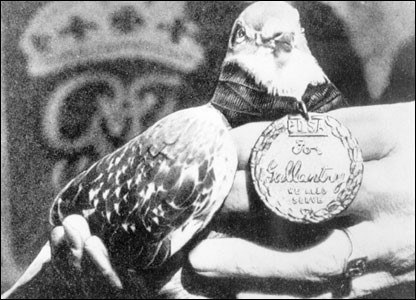The relationship between homing pigeons and man goes back a long way. Mesopotamian clay tablets and Egyptian hieroglyphics show that pigeons were domesticated in North Africa some 5,000 years ago. From these domesticated pigeons, now well-known tame pigeon species have arisen. In ancient times, pigeons were mainly a cheap and nutritious delicacy. The pigeons came to places where there was a lot of agriculture and easy food. This made the pigeon easy to catch for humans, who then started to use homing pigeons for delivering messages strapped to the birds body.
The first carrier pigeons

Paper invention enabled no longer to transfer messages on heavy clay tablets but to light paper. Small, short messages could be written on small pieces of paper and tied to a pigeon. Then the pigeon would fly to the destination. The Romans and ancient Greeks already did this, but this became important in the Middle Ages, especially in the Islamic world. The first Caliph of the Abbasids kept in touch with the different parts of his empire through carrier pigeons. For this purpose, pigeon lofts were built in many places, creating a real network of pigeon mail. Read more about how the homing pigeons find their way home here.
Homing pigeons in wartime

Carrier pigeons were frequently used in Europe to convey messages. Homing pigeons proved to be useful messengers, especially during wars. Small and fast, they were able to cover great distances, and they could easily get over enemy lines. During the Eighty Years’ War, pigeons were an important means of communication during the siege of Haarlem and Leiden.
During World War I, carrier pigeons were widely used to carry messages from the front to areas further behind the lines. Pigeons sometimes proved to be more reliable than telephone connections, which were often broken by the large artillery bombardments.
Carrier pigeon – a dangerous profession

That is not to say that the pigeons were not in danger. Carrier pigeons were the snipers’ target, who knew all too well that shooting pigeons could have major consequences for the enemy. This led to several pigeons being awarded war medals. In 1918 the pigeon Cher Ami became famous when she brought a message from imprisoned American troops to their headquarter. The pigeon was hit no less than three times by enemy fire. The pigeon was awarded the highest French army decoration (Legion of Honour). Cher Ami was not trained by the military but was given to the military by homing pigeon breeders.
Pigeon sport

The sport of pigeons is to travel great distances as quickly as possible, and started in Belgium in the early 19th century. Slowly the hobby spread from there to all over Europe. The pigeon keepers, called pigeon fanciers, thought to do competitions in which the pigeons have to fly home from a certain place as quickly as possible. The fastest pigeon wins. Soon the ‘game’ gained in popularity, which involved a lot of money. Not only to buy fast pigeons from their breeders but also to bet on the fastest pigeon.
You won’t see many pigeons delivering messages these days, but the birds are still used in races worldwide. The sport became a hobby after the war as it is affordable for many. But the sport has changed in recent years. Its growing popularity in China, along with its tremendous growth in income, has resulted in people investing hundreds of thousands of dollars in birds with the great results and pedigree. A pigeon sold for a record-breaking $1.4 million in March 2019. This pigeon named Armando had the highest auction price ever. The bird was sold to a Chinese pigeon racer and is said to be the greatest long-distance pigeon ever.

